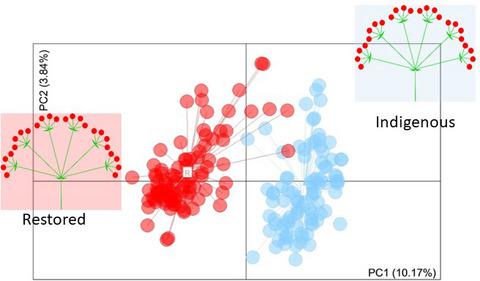当前位置:
X-MOL 学术
›
Plant Biol.
›
论文详情
Our official English website, www.x-mol.net, welcomes your feedback! (Note: you will need to create a separate account there.)
Genotypic and phenotypic distinctness of restored and indigenous populations of Pimpinella saxifraga L. 8 or more years after restoration.
Plant Biology ( IF 3.9 ) Pub Date : 2020-08-18 , DOI: 10.1111/plb.13174 B Gemeinholzer 1 , J Reiker 1 , C M Müller 1 , V Wissemann 1
中文翻译:

恢复的Pimpinella saxifraga L.和恢复的土著群体的基因型和表型差异。恢复后8年或更长时间。
更新日期:2020-08-18
Plant Biology ( IF 3.9 ) Pub Date : 2020-08-18 , DOI: 10.1111/plb.13174 B Gemeinholzer 1 , J Reiker 1 , C M Müller 1 , V Wissemann 1
Affiliation

|
- The recovery of altered or damaged ecosystems demands large‐scale reintroductions of seeds. In the past, ecological restoration in Germany was carried out with non‐local seeds of naturally occurring species. We here analysed whether the genetic pattern of the introduced non‐local seeds (R = restored) of Pimpinella saxifraga are still detectable several years after application and whether the phenotype differs from that of the regional gene pool (I = indigenous) of the species.
- We collected material from individuals of R and I sites, conducted a common garden experiment and tested for genetic, morphological and phenotypic differences. In a cutting experiment we investigate treatment effects on indigenous and restored populations.
- At all investigated sites we only found P. saxifraga individuals with comparatively similar genome sizes. The population genetic analysis revealed two large and quite distinct molecular clusters, separating indigenous and restored individuals along the first axis. None of the vegetative, but two of the reproductive fitness parameters differed between individuals of the R and I sites. Cutting always had a significant influence on all analysed vegetative and reproductive fitness parameters, regardless of the individuals' origin. The effects of mowing always mask origin‐specific characteristics, which then disappear.
- Genotypic coexistence reduces the availability of niches for the local genotype and may eventually lead to genotypic competition or introgression. We therefore recommend not to use non‐local genotypes of this species in the region. Instead, we recommend using the genetically diverse local genotypes of P. saxifraga for restoration purposes.
中文翻译:

恢复的Pimpinella saxifraga L.和恢复的土著群体的基因型和表型差异。恢复后8年或更长时间。
- 恢复变化或破坏的生态系统需要大规模重新引入种子。过去,德国的生态恢复是使用非本地自然物种的种子进行的。我们在这里分析了引入的虎耳草非定形种子的遗传模式(R =恢复)是否在应用后数年仍可检测到,并且该表型是否与该物种的区域基因库(I =本地)不同。
- 我们从R和I站点的个人那里收集了材料,进行了常规的花园实验,并测试了遗传,形态和表型差异。在切割实验中,我们调查了对土著和恢复种群的治疗效果。
- 在所有调查的地点,我们只发现了虎耳草个体的基因组大小相对相似。种群遗传学分析揭示了两个大而完全不同的分子簇,它们沿第一轴将土著和恢复的个体分开。R和I位点的个体之间无营养,但两个生殖适应性参数不同。切割始终对所有分析的营养和生殖健康参数产生重大影响,无论其来源如何。割草的效果总是掩盖原产地的特征,然后消失。
- 基因型共存会降低本地基因型的生态位可用性,并可能最终导致基因型竞争或基因渗入。因此,我们建议不要在该地区使用该物种的非本地基因型。取而代之,我们建议使用虎耳草的遗传多样性的本地基因型进行恢复。



























 京公网安备 11010802027423号
京公网安备 11010802027423号